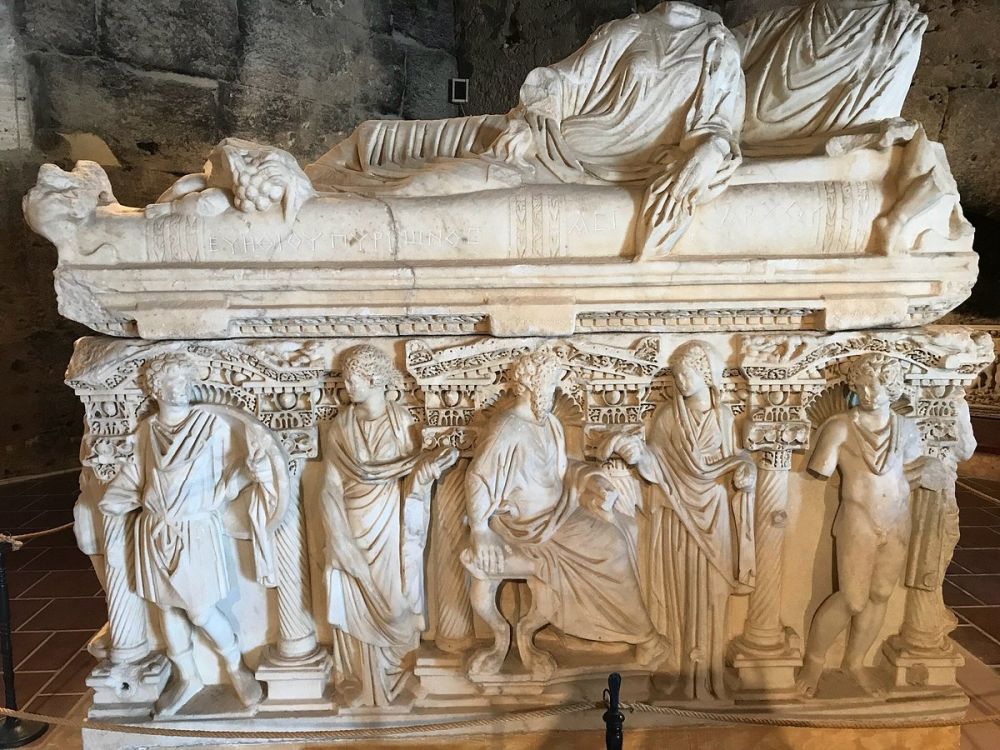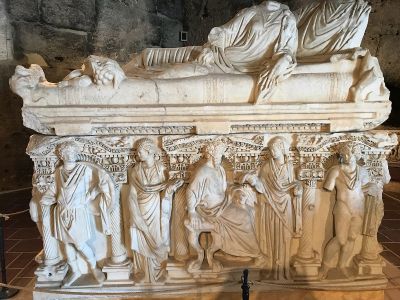

Visitors can immerse themselves in the rich history of Hierapolis by exploring the vast collection of ancient tombs on display at the Hierapolis Archaeology Museum. The exhibition features a variety of tomb styles including sarcophagi, house-shaped tombs, and cylindrical ash containers known as 'unguentaria'. The intricate carvings and inscriptions on these artifacts provide valuable insights into the burial customs, religious beliefs, and social statuses of the ancient inhabitants. Artifacts, including grave offerings and funerary stelae, unearth a deeper understanding of the life and death concepts prevalent during the Greco-Roman period. Each tomb tells its own story, weaving a tapestry of the past that highlights the sophisticated craftsmanship and the artistic skills of the time.
The Hierapolis Theatre Excursion allows visitors to step back in time and experience the grandeur of one of the most well-preserved Roman theatres in Turkey. With a capacity of over 12,000 spectators, this theatre showcases the architectural prowess of the Roman Empire. As guests stroll through the ancient aisles, they can marvel at the decorative friezes that depict various mythological scenes and gain insight into the cultural importance of theatre in ancient societies. The tour not only covers the theatre's history but also provides anecdotes about the performances that would have been staged, from classical plays to gladiatorial combat. The expansive views of the surrounding ruins and valleys from the theatre's upper seating tiers offer a perfect blend of cultural enrichment and visual delight.
The Roman Bath Complex Tour offers a chance to explore the ancient spa facilities that were central to the daily life of Hierapolis. These baths not only served as places for bathing but also as social hubs where people gathered to relax and discuss matters of the day. The tour delves into the advanced engineering behind the hypocaust system—a method of underfloor heating—as well as the varying functions of the frigidarium, tepidarium, and caldarium. The museum building itself is housed in what used to be the Roman Bath, and visitors can admire the classical architecture along with the artifacts that have been carefully preserved to give an authentic sense of the scale and opulence of the baths in their prime.
The Archaeological Artifacts Workshop at Hierapolis Archaeology Museum is an educational activity designed to provide a hands-on experience with the history and conservation of ancient artifacts. Under the guidance of experienced museum professionals, participants can learn about the processes involved in unearthing, restoring, and preserving archaeological finds. The workshop often includes a demonstration of typical restoration techniques used by conservators and provides participants with an opportunity to engage with replicas of the artifacts to understand the delicate nature of archaeological conservation. This rare behind-the-scenes look is not only educational but also facilitates a deeper appreciation for cultural heritage and the meticulous work that goes into its preservation.
Embark on an Ancient Hierapolis Sightseeing Walk and wander through the ruins of this UNESCO World Heritage site, learning about its history as you go. The walk covers notable landmarks such as the Frontinus Street, the Nymphaeum, the Temple of Apollo, and the Martyrium of St. Philip the Apostle, offering comprehensive insights into the religious, social, and commercial aspects of the ancient city. With signage and brochures provided in multiple languages, visitors will learn how Hierapolis thrived through its thermal springs, which served as an attraction for those seeking healing and relaxation. Be sure to wear comfortable shoes, as the walk encompasses a vast expanse of this ancient spa city, revealing clues to its storied past at every turn.
The Ancient Coins and Currency Exhibit offers numismatists and history enthusiasts alike the opportunity to delve into the fascinating world of ancient monetary systems. Displaying a wide array of coins from different epochs, the exhibit demonstrates the evolution of currency in Hierapolis and the surrounding regions. Visitors can examine the detailed imagery and inscriptions on the coins, which often bore the likenesses of rulers, deities, and symbols indicative of the political and religious sentiments of the time. This exhibit is particularly noteworthy for its collection of Byzantine coins, which highlight the transition from pagan iconography to Christian symbolism. It's an engrossing journey through the economic history that has shaped civilizations.
Take a Guided Necropolis Tour and step into one of the largest ancient cemeteries of Anatolia. This activity provides a detailed examination of the elaborate funerary architecture that exemplifies the diverse burial practices of the era. With an expert guide leading the way, visitors learn about the significance of the site and the different types of graves, including monumental tombs and simple burial pits. The guide recounts tales of the people who once lived in Hierapolis, offering a glimpse into the cultural beliefs around death and the afterlife. The Necropolis of Hierapolis, with its numerous sarcophagi stretching out over the hills, makes for a poignant, educational, and somewhat haunting experience.
The Thermal Springs and Antique Pool Dip activity affords guests the unique chance to bathe in the same mineral-rich waters that have been celebrated since antiquity for their healing properties. The Antique Pool, also known as Cleopatra's Pool, is filled with warm, soothing water and ancient marble columns that have fallen from the nearby Temple of Apollo during an earthquake. As visitors float amongst the submerged ruins, they can relish the experience of connecting with history in a tactile and intimate way. It's not just a refreshing dip but also a therapeutic session that echoes the ancient wellness traditions that Hierapolis was famous for.
The Hierapolis Museum Sculpture Collection is an extraordinary exhibition showcasing the mastery of ancient sculptors. This collection includes statues, busts, and frieze fragments, many of which were recovered during excavations of Hierapolis and its surroundings. Featuring depictions of Greek and Roman gods and goddesses, eminent political figures, and mythological heroes, the sculptures provide an invaluable insight into the artistic skills and cultural ideals of the periods they represent. Among the highlights are beautiful reliefs that once graced grand public buildings and private villas, demonstrating the luxury and artistic patronage prevalent in Hierapolis during its heyday.
Photography enthusiasts can indulge in a Photography Exploration through the grounds of the Hierapolis Archaeology Museum and the surrounding ancient city. This activity beckons those with a passion for capturing the essence of historical sites through their lenses. As participants wander the ruins, they have the opportunity to photograph the beautifully preserved theater, the haunting Necropolis, and the stunning vistas provided by the travertine terraces of Pamukkale. This self-guided experience encourages visitors to find unique perspectives and document their journey through a landscape steeped in millennia of history. The interplay of natural light and ancient stone provides ample material for stunning photographic compositions.
